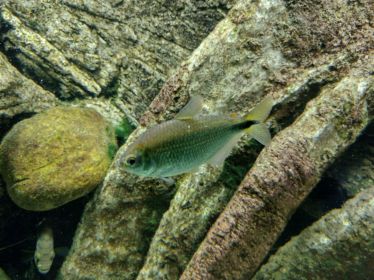- Ground sharks (Carcharhiniformes)
- Carpet sharks (Orectolobiformes)
- Stingrays (Myliobatiformes)
- Skates (Rajiformes)
- Bichir (Polypteriformes)
- Lungfish (Dipnoi)
- Gar (Lepisosteiformes)
- Eel (Anguilliformes)
- Bony-tongued fishes (Osteoglossiformes)
- Carps (Cypriniformes)
-
Tetra (Characiformes)
- Alestidae
-
Characidae
- Blackline penguinfish (Thayeria boehlkei)
- Cardinal tetra (Paracheirodon axelrodi)
- Gold tetra (Hemigrammus rodwayi)
- Mexican tetra (Astyanax mexicanus)
- Red Laser Tetra (Hemigrammus coeruleus)
- Red phantom tetra (Hyphessobrycon sweglesi)
- Saiz's tetra (Hyphessobrycon saizi)
-
Twospot astyanax (Astyanax bimaculatus)
- Distichodontidae
- Gasteropelecidae
- Lebiasinidae
- Serrasalmidae
- South American knifefish (Gymnotiformes)
- Catfish (Siluriformes)
- Salmon (Salmonidae)
- Pikes (Esociformes)
- Cod fish (Gadiformes)
- Cardinalfish (Kurtiformes)
- Gobies (Gobiiformes)
- Pipefish (Syngnathiformes)
- Gouramies (Anabantiformes)
- Flatfish (Pleuronectiformes)
- Cichlides (Cichliformes)
- Rainbowfish (Atheriniformes)
- Killifish (Cyprinodontiformes)
- Blenny (Blenniiformes)
- Wrasse (Labriformes)
- Anglerfish (Lophiiformes)
- Pufferfish (Tetraodontiformes)
- Scorpionfish (Scorpaeniformes)
- Ray-finned fish (Perciformes)
- Dragonet (Callionymiformes)
- Weever (Trachiniformes)
Twospot astyanax (Astyanax bimaculatus)

Picture taken in Pecs, Hungary
The twospot astyanax (Astyanax bimaculatus), also called the two-spot tetra, is a small species of freshwater fish native to South America. It is a middlingly common tetra in the aquarium industry, with hobbyist reports of its sale and presence, and it is also a well-studied member of the genus Astyanax in wild settings. Amateur aquarists report peaceful schooling behavior in captivity, though fish in wild schools may turn on one another if presented with the threat of a predatory species. Its very earliest report was by prolific taxonomist Carl Linnaeus in 1758, in the 10th edition of Systema Naturae. Linnaeus designated it a member of genus Salmo, and since then it has also been considered a member of the genus Tetragonopterus before being placed in Astyanax. Currently, A. bimaculatus is at the center of a species complex, and specific species relationships are still being deciphered in modern ichthyological studies. As it stands, no monophyly can be guaranteed from A. bimaculatus. Astyanax bimaculatus is omnivorous, eating plants, zooplankton, and various forms of detritus. It is also known to occasionally target other fish to eat their scales. In turn, A. bimaculatus is regularly preyed upon by Hoplias malabaricus, the trahira, as well as various heron species (genus Ardea). It is also host to a variety of parasites, most often flukes (Monogenea). Further, A. bimaculatus is a farmed fish for human use, such as consumption or bait.
In Aquariums and Zoos: rare in Europe
In Aquariums and Zoos: rare in Europe
woaqzo@yahoo.com